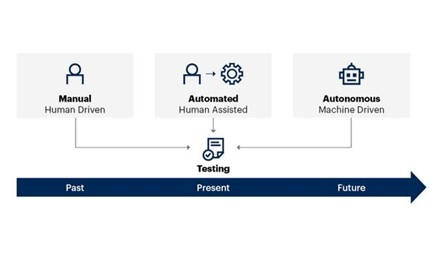Introduction
Software development has evolved rapidly over the years, with advancements in agile methodologies, DevOps practices, and continuous integration/continuous deployment (CI/CD) pipelines. However, as software applications become more complex, the need for efficient and effective testing is more crucial than ever. This is where autonomous testing steps in, offering a game-changing approach to software testing.

Pic courtesy – Joachim Herschmann
What is Autonomous Testing?
Autonomous testing, also known as self-testing or automatic testing, is an innovative approach to software testing that leverages automation, artificial intelligence (AI), and machine learning (ML) to conduct testing activities with minimal human intervention. It encompasses a range of testing types, from functional and regression testing to performance and security testing.
The core idea behind autonomous testing is to:
- Accelerate Testing: By automating test case creation and execution, autonomous testing significantly speeds up the testing process.
- Increase Test Coverage: With the ability to run a large number of test cases swiftly, autonomous testing improves test coverage, ensuring that more parts of the software are tested.
- Enhance Reliability: Automated tests are consistent and less prone to human error, resulting in more reliable testing outcomes.
Key Components of Autonomous Testing
- AI and ML Algorithms:
Autonomous testing tools utilize AI and ML algorithms to analyze application behavior, learn from test results, and adapt to changes in the software. This enables tests to evolve over time, reducing the need for frequent test case maintenance.
- Test Automation Frameworks:
Autonomous testing relies on robust test automation frameworks, such as Selenium, Appium, or proprietary tools built specifically for autonomous testing. These frameworks provide the foundation for creating and executing automated test scripts.
- CI/CD Integration:
To seamlessly fit into modern software development pipelines, autonomous testing integrates with CI/CD processes. Tests are automatically triggered upon code commits, ensuring continuous testing and rapid feedback.
- Test Reporting and Monitoring:
Autonomous testing tools generate comprehensive test reports in real-time, allowing teams to monitor test execution progress and quickly identify issues.
The Benefits of Autonomous Testing
- Consistency:
Automated tests consistently follow predefined steps, reducing the risk of human error and ensuring reliable test results.
- Speed:
Autonomous testing enables the execution of a large number of test cases in a short period, accelerating the testing phase.
- CI/CD Integration:
Autonomous testing fits seamlessly into the CI/CD pipeline, ensuring that testing is an integral part of the development process.
- Reusability:
Test scripts created for autonomous testing can be reused across different stages of the development lifecycle, reducing redundancy.
Challenges in Autonomous Testing
Despite its many advantages, autonomous testing presents some challenges:
- Initial Setup:
Setting up autonomous testing environments and creating automated test cases can be time-consuming and require significant effort.
- Maintenance:
Automated tests need regular maintenance to keep up with changes in the application or the testing environment.
- Test Data Management:
Managing test data can be complex, especially for applications relying on large datasets or databases.
- Test Environment Variability:
Variations in the test environment can lead to flaky tests, which require careful handling.
The Future of Autonomous Testing
As software applications continue to grow in complexity and release cycles become shorter, autonomous testing will play an increasingly vital role in ensuring software quality. AI and ML will continue to evolve, making autonomous testing tools smarter and more adaptable.
Trending Autonomous Testing Tools
The world of autonomous testing is filled with innovative tools designed to streamline the testing process. Here are 3 trending autonomous testing tools that are making waves in the software testing industry:

Katalon Studio
- Type: Integrated Test Automation Platform
- Supported Testing: Web, Mobile, and API Testing
- Key Features:
- Comprehensive Testing: Katalon Studio offers a wide range of testing capabilities, including web, mobile, and API testing, making it a versatile choice for test automation.
- User-Friendly IDE: Katalon Studio provides a user-friendly Integrated Development Environment (IDE) that simplifies test case creation, allowing testers to build scripts without extensive programming knowledge.
- Built-In Test Objects: It includes a built-in test object repository, simplifying the identification and management of web and mobile elements.
- Integration with CI/CD: Katalon Studio seamlessly integrates with popular CI/CD systems, making it suitable for continuous testing in modern software development workflows.
- Large Community: Katalon has a vibrant user community, offering a wealth of resources, forums, and support to users.
- Considerations:
- Pricing: While Katalon Studio offers a free version, the pricing for the paid versions can be relatively high for organizations with limited testing budgets.

TestRigor
- Type: Codeless Autonomous Testing Tool
- Supported Testing: Web, Mobile, and Desktop Applications
- Key Features:
- Ease of Use: TestRigor offers a codeless approach, allowing testers to create end-to-end UI test cases using plain English, making test case development more accessible and faster.
- Cross-Platform Compatibility: It supports a wide range of browsers and multiple operating systems, ensuring that your tests are compatible with various environments.
- Integration: TestRigor seamlessly integrates with CI/CD systems, test case management tools, and infrastructure providers, enhancing its adaptability within your existing testing ecosystem.
- Considerations:
- Pricing: While TestRigor provides a robust feature set, it’s essential to note that pricing can be relatively higher compared to some automated testing tools.

Mable
- Type: AI-Driven Autonomous Testing Tool
- Supported Testing: UI, API, and Performance Testing
- Key Features:
- Adaptive Testing: Mable uses AI to automatically adapt test cases to changes in the application, reducing the need for extensive test case maintenance and enhancing testing reliability.
- AI-Healing: The tool is equipped with AI-powered capabilities that can self-heal and make necessary adjustments to tests, ensuring robust test case execution.
- Considerations:
- Test Speed: Mable’s support for certain types of software testing may be limited, so it’s crucial to ensure it aligns with your specific testing needs.
Conclusion
By overcoming challenges and embracing the benefits of autonomous testing, organizations can enhance their software quality and meet the demands of today’s fast-paced software development landscape.


Thank you for sharing good information.